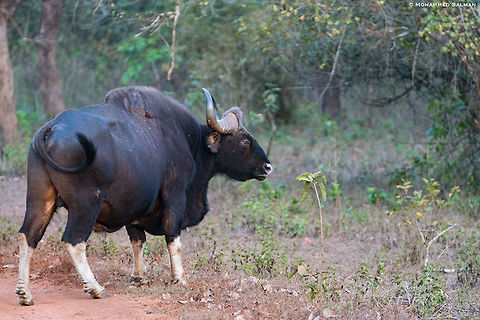
Appearance
The gaur is a strong and massively built species with a high convex ridge on the forehead between the horns, which bends forward, causing a deep hollow in the profile of the upper part of the head.There is a prominent ridge on the back. The ears are very large; the tail only just reaches the hocks, and in old bulls the hair becomes very thin on the back.
In colour, the adult male gaur is dark brown, approaching black in very old individuals; the upper part of the head, from above the eyes to the nape of the neck, is, however, ashy grey, or occasionally dirty white; the muzzle is pale coloured, and the lower part of the legs are pure white or tan.
The cows and young bulls are paler, and in some instances have a rufous tinge, which is most marked in groups inhabiting dry and open districts. The tail is shorter than in the typical oxen, reaching only to the hocks.
They have a distinct ridge running from the shoulders to the middle of the back; the shoulders may be as much as 12 cm higher than the rump. This ridge is caused by the great length of the spinous processes of the vertebrae of the fore-part of the trunk as compared with those of the loins. The hair is short, fine and glossy, and the hooves are narrow and pointed.
The gaur has a head-and-body length of 250 to 330 cm with a 70 to 105 cm long tail, and is 165 to 220 cm high at the shoulder. The average weight is 650 to 1,000 kg, with an occasional large bull weighing up to 1,500 kg. Males are about one-fourth larger and heavier than females.
Gaur are among the largest living land animals. Only elephants, rhinos, the hippopotamus and the giraffe consistently grow heavier. Two species that naturally co-exist with the gaur are heavier: the Asian elephant and Indian rhinoceros.
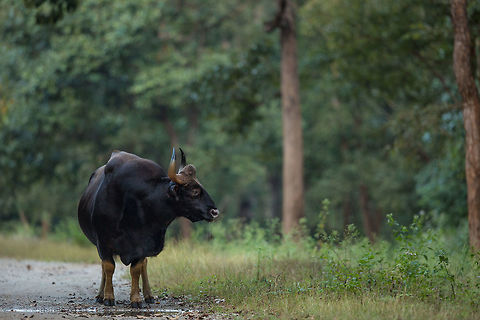
Naming
The Sanskrit word गौर gaura means white, yellowish, reddish. The Sanskrit word "gaur-mriga" means a kind of buffalo. The Hindi word गौर gaur means fair-skinned, fair, white.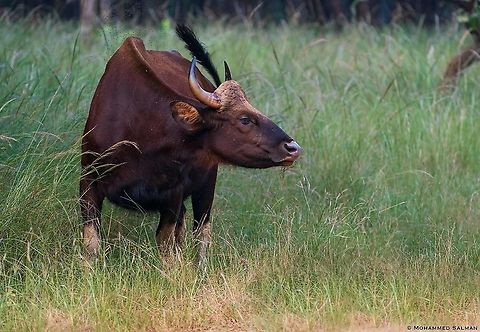
Distribution
Gaur historically occurred throughout mainland South and Southeast Asia, including Vietnam, Cambodia, Laos, China, Thailand, Peninsular Malaysia, Myanmar, India,Bangladesh, Bhutan, and Nepal. Today, the species is seriously fragmented within its range, and regionally extinct in Sri Lanka.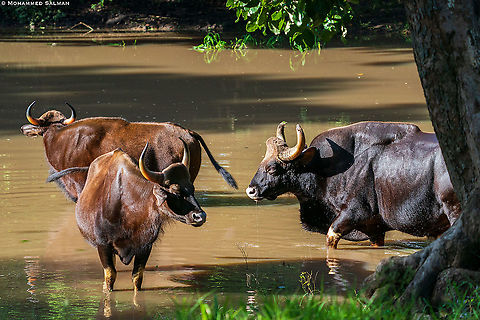
Behavior
Where gaur have not been disturbed, they are basically diurnal. In other areas, they have become largely nocturnal due to forest molestation caused by people. In central India, they are most active at night, and are rarely seen in the open after 8 o'clock in the morning.During the dry season, herds congregate and remain in small areas, dispersing into the hills with the arrival of the monsoon. While gaur depend on water for drinking, they do not seem to bathe or wallow.
In January and February, gaur live in small herds of eight to 11 individuals, one of which is a bull. In April or May, more bulls may join the herd for mating, and individual bulls may move from herd to herd, each mating with many cows. In May or June, they leave the herd and may form herds of bulls only or live alone. Herds wander 2–5 km each day. Each herd has a nonexclusive home range, and sometimes herds may join in groups of 50 or more. The average population density is about 0.6 animals per square kilometre, with herds having home ranges of around 80 km2.
Gaur herds are led by an old adult female, the matriarch. Adult males may be solitary. During the peak of the breeding season, unattached males wander widely in search of receptive females. No serious fighting between males has been recorded, with size being the major factor in determining dominance. Males make a mating call of clear, resonant tones which may carry for more than 1.6 km. Gaur have also been known to make a whistling snort as an alarm call, and a low, cow-like moo.
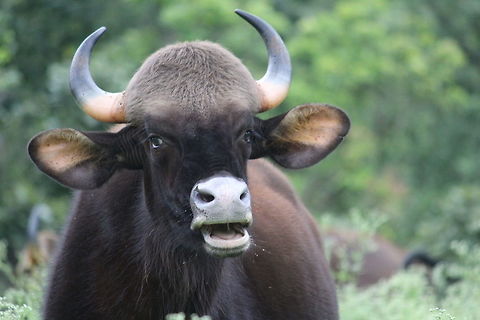
Habitat
Gaur are largely confined to evergreen forests or semi-evergreen and moist deciduous forests, but also occur in deciduous forest areas at the periphery of their range.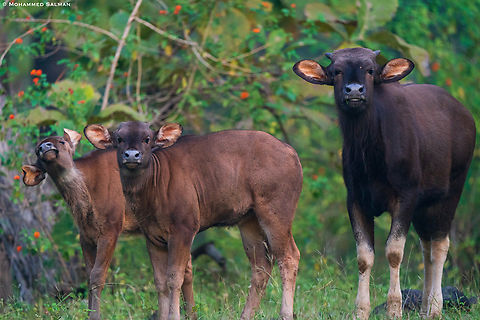
Reproduction
Gaur have one calf after a gestation period of about 275 days, about nine months, a few days less than domestic cattle. Calves are typically weaned after seven to 12 months. Sexual maturity occurs in the gaur's second or third year. Breeding takes place year-round, but typically peaks between December and June. The lifespan of a gaur in captivity is up to 30 years.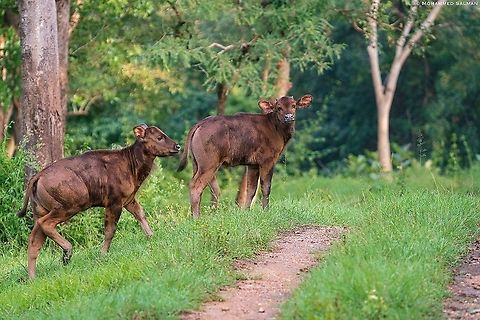
Food
Wild gaur graze and browse on a wider variety of plants than any other ungulate species of India, with a preference for the upper portions of plants, such as leaf blades, stems, seeds and flowers of grass species, including "kadam".![Time to disappear! The Gaur AKA "Indian Bison" (Bos Gaurus) - Judging by its physical characteristics and that it is alone, the Gaur in the image is a male [Gaur herds are lead by female Gaurs (matriarchy)]. I spotted this lone ranger on top of the Brahmagiri hills, during our trek there (me and a group of friends).
The bull was nearly half a mile away from our location, but he was able to hear even the tiniest of the sounds we made, which is when we appeared in its radar and it started looking in our direction. That is when I clicked the image, and then we all sat on the ground silently until the Gaur walked away in the opposite direction and soon disappeared in to the thick canopy near by. Bos gaurus,Gaur,Geotagged,India,animal,bos gaurus,brahmagiri hills,bull,gaur,jungle,kodagu,western ghats,wild](https://s3.amazonaws.com/media.jungledragon.com/images/1940/21965_small.jpg?AWSAccessKeyId=05GMT0V3GWVNE7GGM1R2&Expires=1767225610&Signature=vmpnQfIRaZk4mJnQ%2BM5kS4wla5o%3D)
Predators
In Laos, gaurs are highly threatened by poaching for trade to supply international markets, but also by opportunistic hunting, and specific hunting for home consumption. In the 1990s, they were particularly sought by Vietnamese poachers for their commercial value.In Thailand, gaurs are highly threatened by poaching for commercial trade in meat and trophies.
References:
Some text fragments are auto parsed from Wikipedia.
